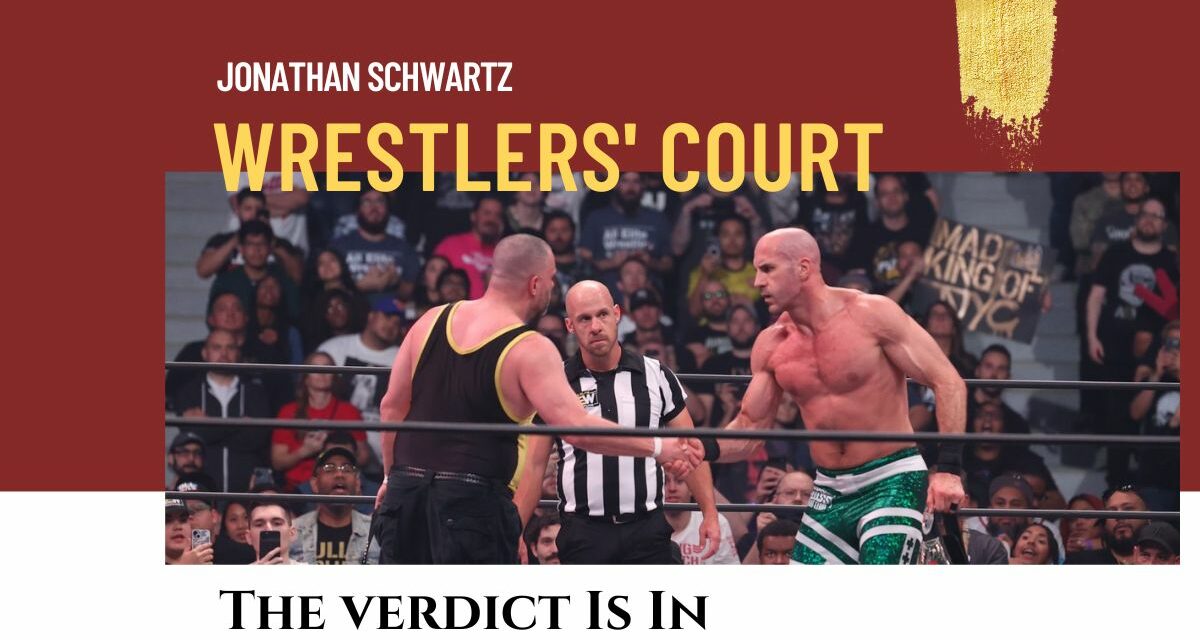On the November 11 edition of All Elite Wrestling (AEW) Collision, CEO Tony Khan made one of his patented ‘important announcements’. In this case, Mr. Khan spread the news of an upcoming ‘Continental Classic’ tournament which would start November 22 and wrap up at the AEW World’s End pay per view on December 20. The first set of tournament matches have now taken place, and for the most part they’ve been fun. Mr. Khan has engaged some of his better in-ring performers for the tourney. It’s hard to go wrong with matches like Jay Lethal vs. Swerve Scott (who should win the whole darn thing and get a world title run — he’s awesome) or Jay White vs. RUSH (White would be my second pick). But I’ll get back to them later.
If you follow New Japan Pro Wrestling (NJPW), the tournament’s format is familiar. Twelve wrestlers are divided into two groups of six: a Gold League and a Blue League. Wrestlers will compete against others in their league in a round-robin tournament, with in-group finals slated for the month before World’s End. At this stage, winners receive three points for a win, one point for a draw, no points for a loss. No one is allowed at ringside for the matches, to add to the stakes.
The competitors are divided as follows:
Blue League:
- Bryan Danielson
- Andrade El Idolo
- Brody King
- Claudio Castagnoli
- Daniel Garcia
- Eddie Kingston
Gold League:
- Jon Moxley
- Swerve Strickland
- RUSH
- Mark Briscoe
- Jay Lethal
- Jay White
Knowing Khan’s love of tournaments and his willingness to introduce new accessories to his shows, the Continental Classic doesn’t feel especially newsworthy. AEW has an assortment of themed battle royales, tournaments and ladder matches aimed at driving its storylines forward and building new contenders to the promotion’s alphabet soup of titles.
What was newsworthy was current Ring of Honor (ROH) World Champion Eddie Kingston’s announcement at the recent Full Gear pay per view that the winner of the Continental Classic would not only become the first AEW Continental Champion and rule over Canada and Mexico with an iron spinning backfist, but would also win the ROH and NJPW Strong Openweight Championships.
No sir, I don’t like it.
And I imagine most ROH fans feel the same.
Before I get to the broader idea behind consolidating pro wrestling titles, let me state that whatever Mr. Khan seeks to gain in creating a new title, he seems to be giving up on the idea of ROH as a separate functioning brand.
I (and others) warned him when he first purchased ROH in March, 2022 (you can read all about it here: WRESTLER’S COURT: CAUTIONARY STORIES OVER ROH SALE).
There are plenty of examples where one wrestling promotion acquires another with the intent of running both successfully. It almost never happens, with the result that one brand is subsumed by the other with a resultant loss of jobs, money and attention to the surviving brand. Promoters like Mr. Khan buy their competitors as they fall into distress, salvage whatever intellectual property assets they can, and in some cases try to bring the dying company’s talent on board. It’s worth noting that the Continental Classic boasts several pre-purchase ROH stars. Danielson, RUSH and Lethal are all former ROH World Champions. Mark Briscoe is a multiple-time tag team champion (and could be seen as taking a spot that was made for his late brother, Jay-himself a two time ROH World champion). Claudio Castagnoli and Eddie Kingston have feuded over the current version of the title, and in an alternate reality, Brody King should be a dominant heel champ. Samoa Joe is conspicuous by his absence.
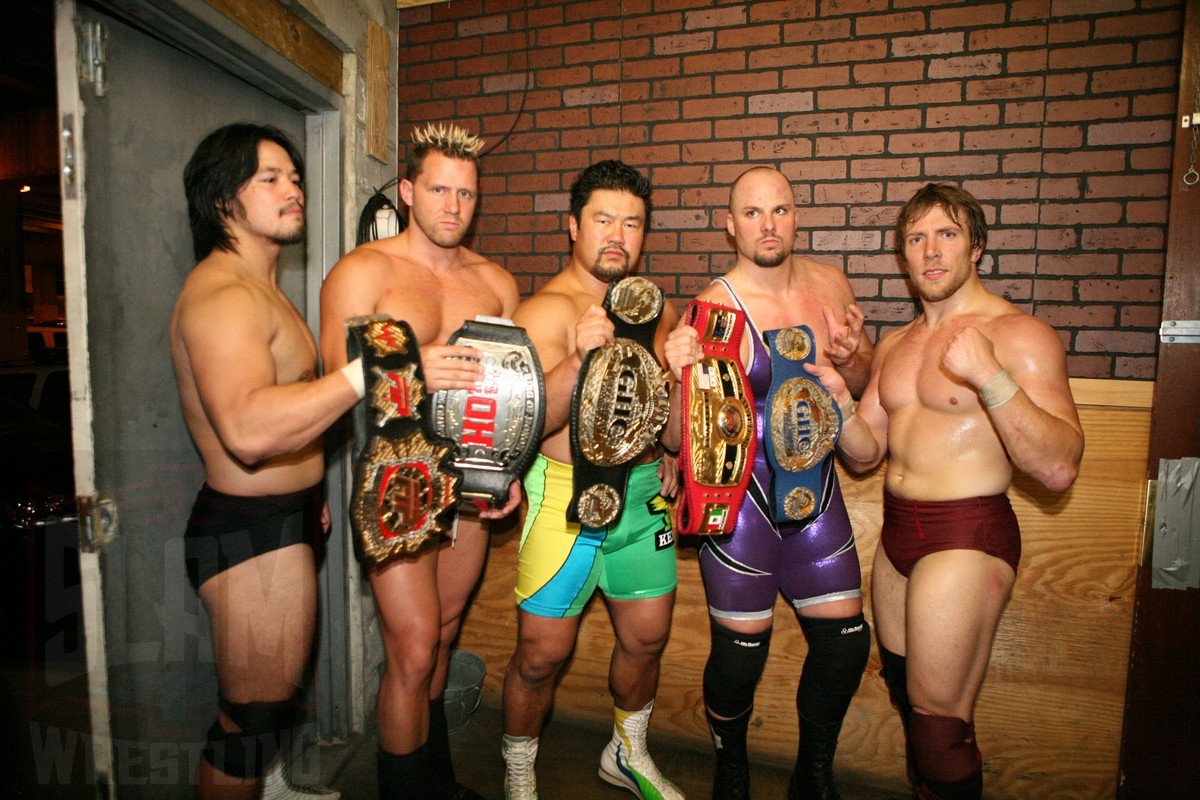
Go Shiozaki, Nigel McGuinness, Kensuke Sasaki, Adam Pearce, Bryan Danielson in Ring of Honor. Photo by George Tahinos, georgetahinos.smugmug.com
That said, when a promotion’s ownership changes hands audiences are often fickle and stick to the vision historically associated with their favorite fed. The new promotion’s guys don’t necessarily blend well into their larger corporate home, and backstage politics and egos eventually lead what could be a fruitful pairing into a desert of fan resentment. In the present case AEW was born of the ashes of ROH. Mr. Khan (along with Impact and WWE, to be fair) raided Bullet Club-era ROH to the point that it could no longer compete. ROH burned itself out honoring its performers contracts through the COVID pandemic when bigger federations were letting talent go.
The worst-case scenario, as realized when WWE acquired the bones of its chief competitor, World Championship Wrestling (WCW), happens the newly acquired entity ceases to be. Fans who were loyal to their specific brand of wrestling find other forms of entertainment and leave pro wrestling behind. If you can be bothered to look over historic TV ratings you’ll see what I mean. When WWE won the Monday Night Wars, their ratings did not grow to encompass WCW fans. In fact, they steadily declined. Many WCW viewers never made the switch, and it’s arguable that they remained disengaged from pro wrestling entirely-though some may have come back to fuel AEW’s growth.
I was hopeful that given Mr. Khan’s appetite for change, he would prove the exception to the above.
A year and a half later this hope feels misplaced.
Mr. Khan commissioned new title belts for ROH and brought in beloved announcers and referees. Unfortunately, he did not land a separate television contract for ROH which would have made it a going concern. As a result, ‘Ring of Honor’ matches air on a subscription-based website or are featured intermittently on AEW broadcasts-whenever Mr. Khan would be reminded that he had a second promotion on the books. Worse, like those before him, Khan privileged identifiably AEW talent over the wrestlers who were left when ROH shut down. I acknowledge this is an artificial divide. As stated above, most wrestlers working with AEW (including a majority of tournament contenders) and WWE have spent some time in ROH.
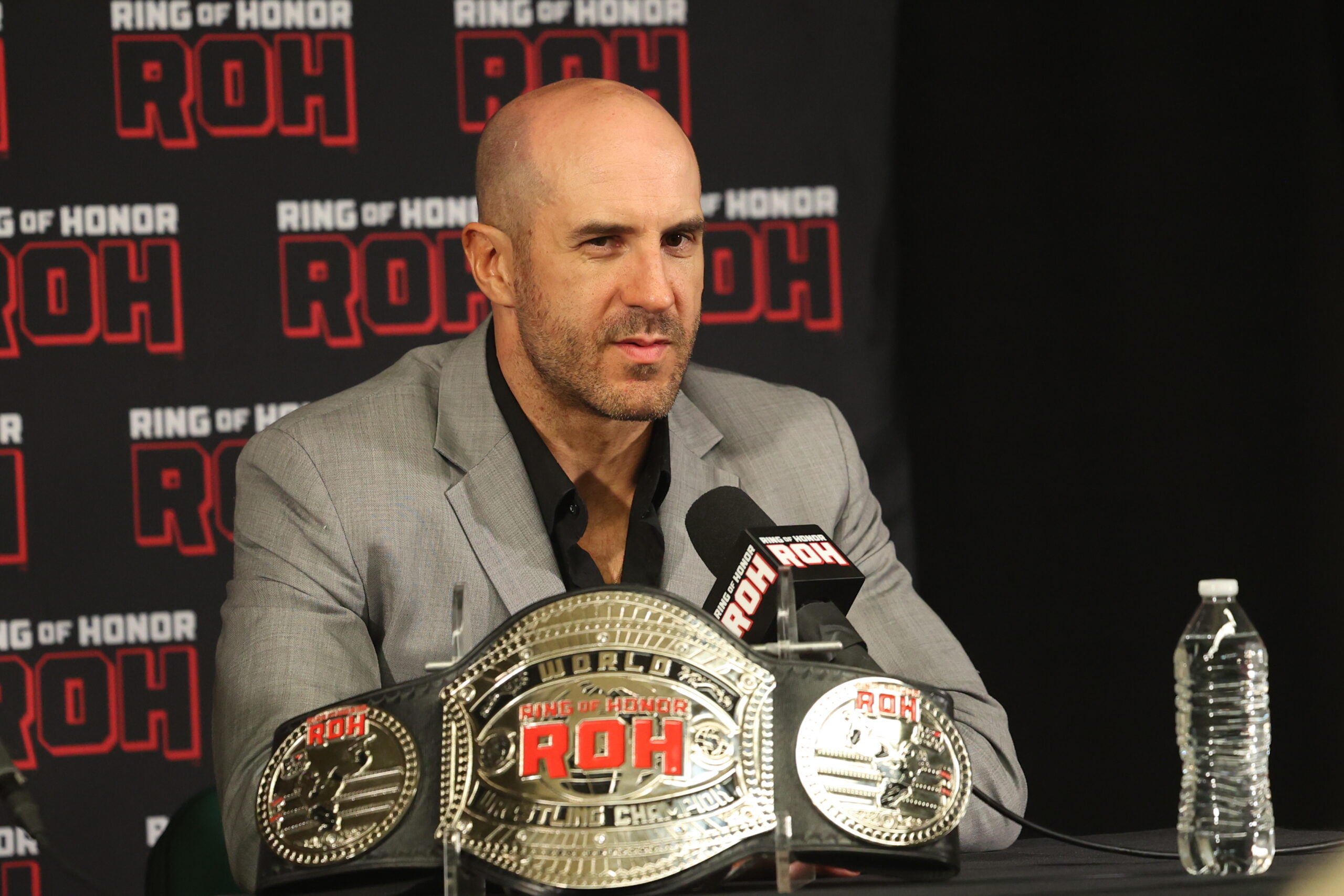
ROH World Champion Claudio Castagnoli at media scrum at CURE Insurance Arena, in Trenton, on Friday, July 21, 2023. Photo by George Tahinos, georgetahinos.smugmug.com
But Claudio Castagnoli’s fan-service title runs, or Chris Jericho’s use of the entire promotion as a means of getting heat weren’t going to appease die-hard fans. The ROH tag team championship has become a prop to MJF-Adam Cole frenemy storyline and has been defended by MJF alone or with Samoa Joe in the service of an AEW title program. The ROH Television Championship, which only sees TV time on AEW shows, was recently thrown down by Joe, who’d held the belt for over 500 days. I’m told that there will be a six-man match to determine a new titlist at the next AEW pay-per-view, but if Joe cared so little as to toss the belt aside as a distraction from his AEW title pursuits, then I don’t know why I should care either. I don’t care about the resurrected Pure, Six Man or Women’s belts either.
I like Eddie Kingston as ROH champion, even if he looks more like I would were I to wear a tank top and cargo pants to the office than a Generational Talent or Tribal Chief. I understand that for ROH fans who loved the promotion’s emphasis on well-rounded, wrestling-first action Kingston is an odd choice for a standard bearer. He is clearly a student of professional wrestling. His best work comes outside the ring. Kingston’s funny, foul-mouthed, fourth wall-breaking promos are excellent. He’s the anti-Castagnoli (it helps that there seems to be real-life antipathy between the two). Claudio can execute pretty much any move against any opponent, but as good as he is as a wrestler he’s never figured out how to connect with an audience. Kingston is no Dory Funk Jr. in-ring, but he comes close to channeling Terry Funk on the microphone. His victory over Castagnoli for the ROH title felt real — which is why it’s so strange that he and Mr. Khan are giving it up.
Mr. Khan’s stated intent in merging the ROH, NJPW Strong and his debuting Continental Championship is to create his own version of Japan’s Triple Crown with AEW branding. Doing so at the expense of the ROH name feels sad. ROH has a 21-year history which includes some of the best pro wrestlers in the world. ROH has had its share of questionable champions (Jay Briscoe, Michael Elgin, Matt Taven and PCO spring to mind). However, wrestlers like Samoa Joe, Bryan Danielson, Kevin (Owens) Steen, Tyler (Seth Rollins) Black, and CM Punk have dominated wrestling discourse. ROH’s influence on how wrestling is presented will reverberate for years to come. If Mr. Khan had wanted, most former ROH champions are (or until recently were) employed by AEW, along with the likes of Adam Cole, Roderick Strong and Dalton Castle.
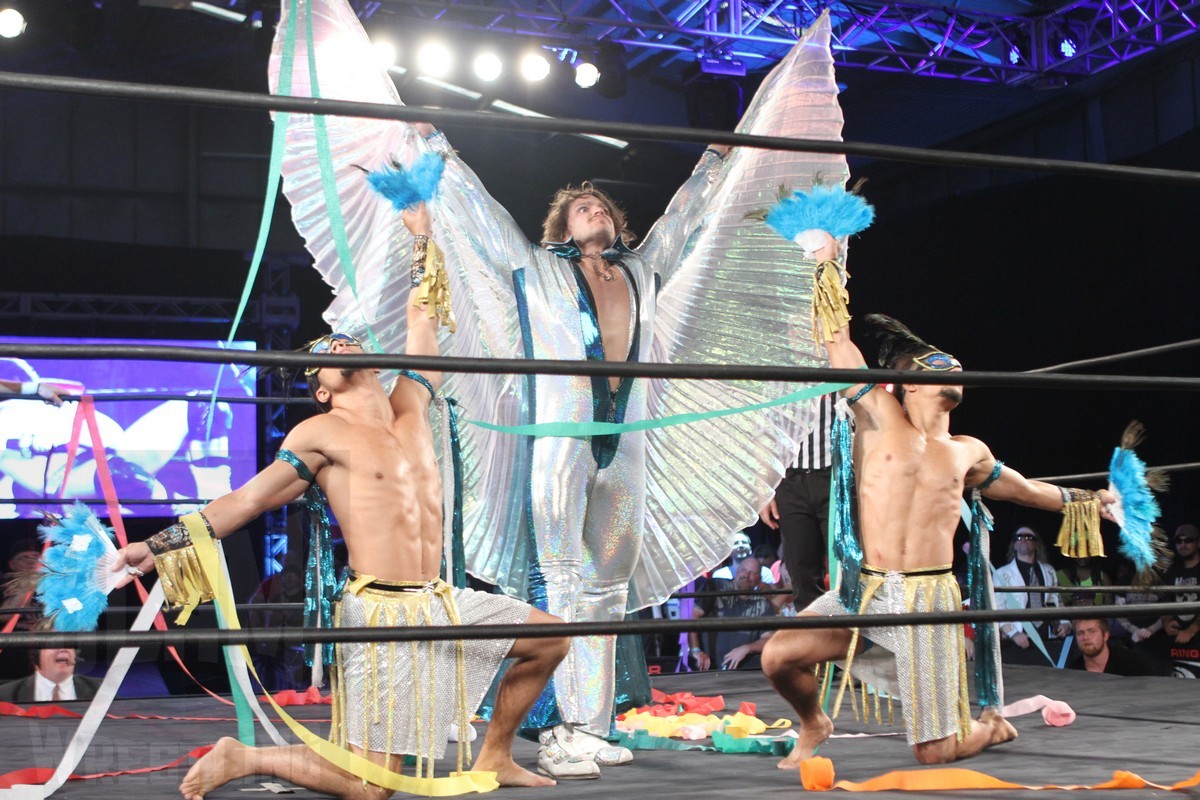
Dalton Castle and The Boys in Ring of Honor. Photo by George Tahinos, georgetahinos.smugmug.com
Instead, an established, prestigious championship with actual world title recognition is slotted alongside the NJPW Openweight Championship, which goes back to 2021 and feels less important following NJPW’s scaling back of its US operations. NJPW initially had plans for a separate NJPW Strong television show which would have raised it’s profile, but those seem to have been shelved. NJPW Strong lacks recognition even though Mr. Khan has permission to appropriate the title for his own uses. The ‘AEW Triple Crown’ also equivocates the ROH title with the AEW Continental Championship, which does not yet exist.
Calling the combined title the AEW Triple Crown Championship which means ROH no longer has a standalone world champion. It effectively values this title at the same level as a neglected NJPW branch plant belt and a fictional title that ranks fourth among AEW belts. On its own I can’t see the Continental Championship garnering more prestige out of the gate than the AEW World, TNT or International Championships (in fairness, I don’t know which of the other belts is meant to mean more than which. I’d rather see the TNT, International and FTW belts merge, but I’ll describe the challenges therein shortly). Heck, the FTW champion may not be officially recognized, but with a lineage going back to the original ECW it has elevated Hook. Mr. Khan’s folding the ROH belt into this mix minimizes the title and the promotion itself.
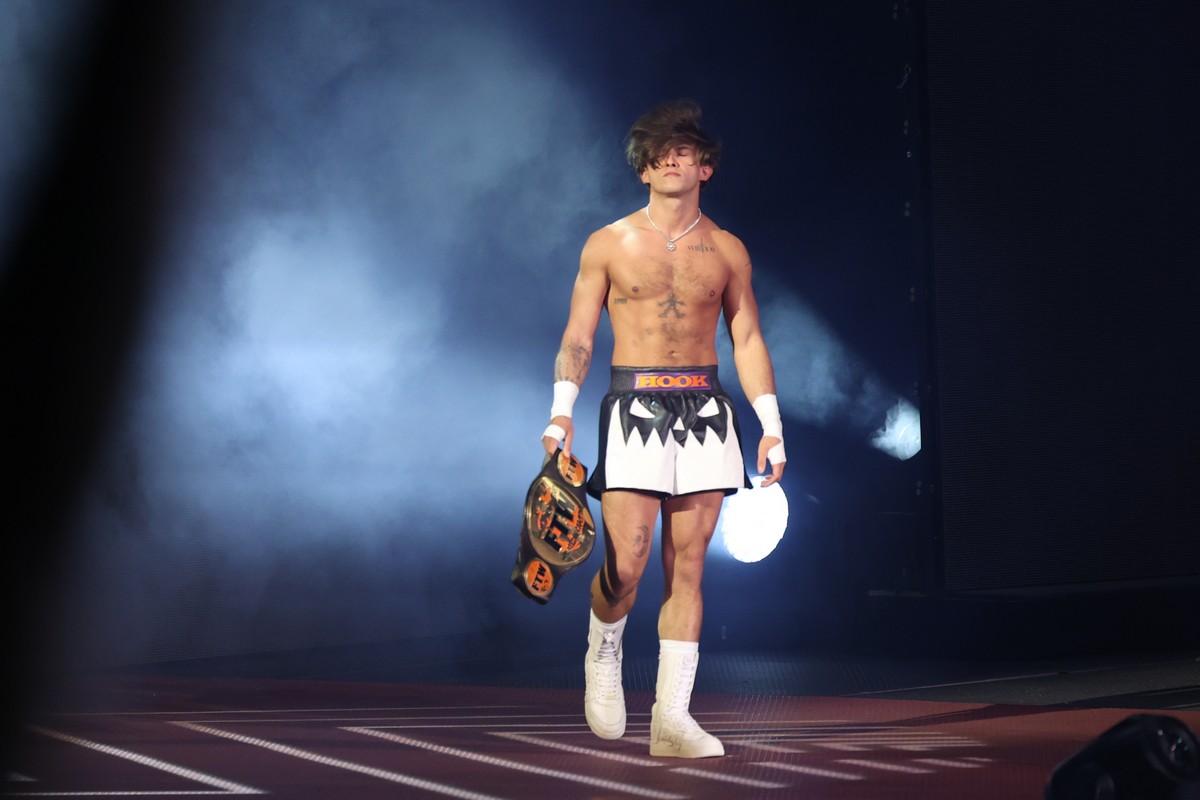
FTW Champion Hook’s entrance at TD Garden, in Boston, on Wednesday, July 19, 2023. Photo by George Tahinos, georgetahinos.smugmug.com
AEW is not the first promotion to merge a set of title belts. Mergers within promotions are common. The original ROH Pure title was amalgamated into the ROH World Championship. The FTW title was unified with the ECW Championship. Championship unifications between promotions usually happen under one of two circumstances: either one promotion buys another and seeks to enhance its own prestige by incorporating the second promotion’s legacy by reference, or multiple, threatened promotions figure they have a better shot at survival if they team up. The former may succeed, although ego too frequently wins out. The latter almost never works because ego too frequently wins out.
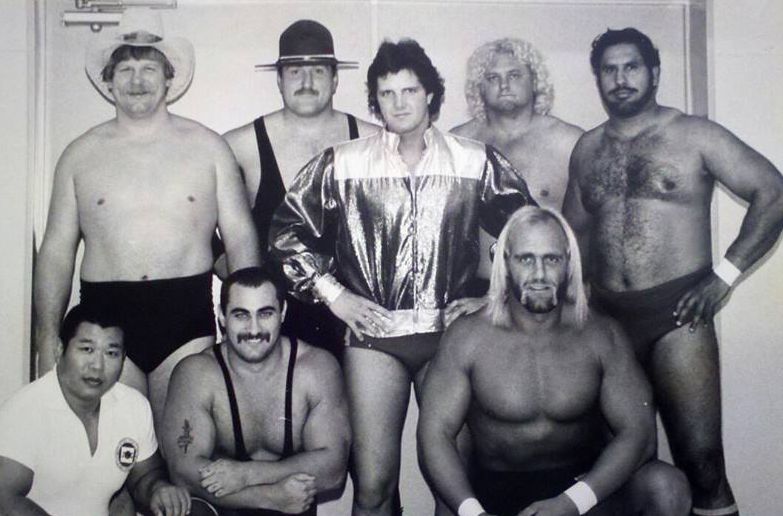
A 1980 tour of Japan included, clockwise from top left, Stan Hansen, Sgt. Slaughter, Chris Adams, Bobby Duncum Sr., Tiger Jeet Singh, Hulk Hogan, Mike Masters and referee Teruo Takahashi.
The Japanese Triple Crown from which Khan draws inspiration is best known as All Japan Pro Wrestling’s (AJPW) heavyweight title. It was established with the unification of the then-Pacific Wrestling Federation (PWF) World Heavyweight Championship with the National Wrestling Alliance’s United National Championship and International Heavyweight Championship (itself forged through a partnership between the NWA and the Japan Pro Wrestling Alliance). The Triple Crown was born in April 1989 when International Heavyweight Champion Jumbo Tsuruta beat PWF and United National Champion (and perennial gaijin heel) Stan Hansen to unify the titles. The Triple Crown was defended as a set of three separate belts (plus a trophy until 2000) until 2013 when the belts were presented to All Japan founder Giant Baba’s widow Motoko and a new, single title belt was used. This version of the Triple Crown continues to be defended as AJPW’s main title. Like AEW and ROH, the promotions which originally comprised Japan’s Triple Crown were absorbed into AJPW from the beginning.
If AEW thinks its proposed Triple Crown is impressive, consider the J-Crown. Introduced by New Japan Pro Wrestling in 1996, the J-Crown unified eight lighter-weight titles from promotions across the globe-including significant belts from Japan, Mexico, the US and the UK.
Shockingly, the J-Crown included the then-WWF’s light-heavyweight championship, which had originally been created in 1981 for the Mexican Universal Wrestling Association (UWA) as the result of a partnership between the WWF and UWA. This version of the Light Heavyweight championship was never formally acknowledged States-side but following the UWA’s closure in 1995 it would become part of Japan’s Michinoku Pro Wrestling before being incorporated into the J-Crown.
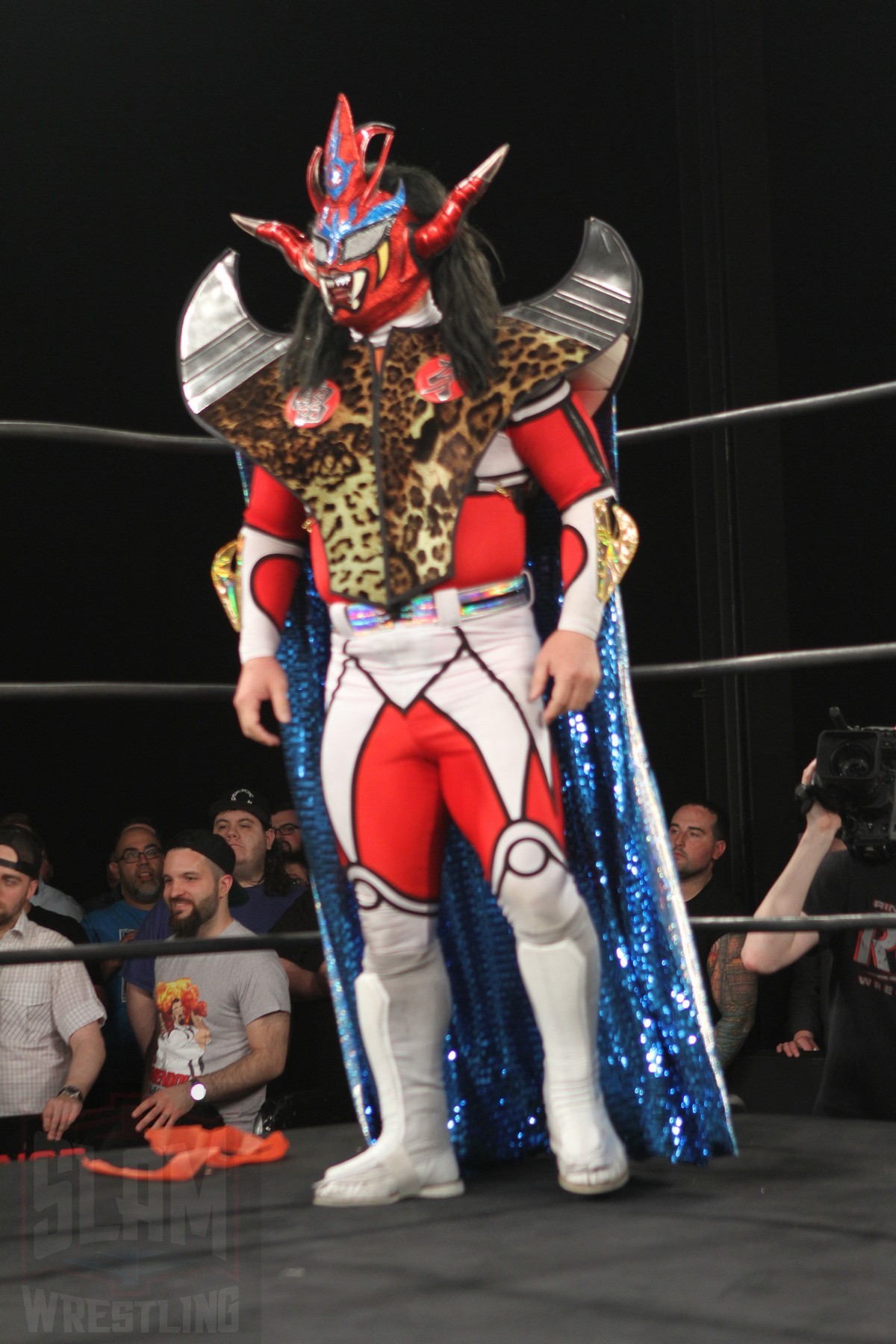
Jushin Thunder Liger in Ring of Honor. Photo by George Tahinos, georgetahinos.smugmug.com
The J-Crown was created through a four-night tournament in August, 1996. It was said to be Jushin ‘Thunder’ Liger’s brainchild and the combined title was held by a string of hall-of-famers including Great Sasuke, Ultimo Dragon (who brought the J-Crown to WCW and added the WCW Cruiserweight championship to the mix, at least temporarily), Liger himself, El Samurai and the final champion, Shinjiro Otani. The J-Crown would be retired in November 1997 when the WWF suddenly realized that it had a branded title floating around wrestling’s multiverse-including on WCW broadcasts. The WWF demanded that Otani vacate and return the belt to facilitate WWF’s development of its own Light Heavyweight division. Otani would also vacate the balance of the J-Crown belts, save the IWGP Junior Heavyweight Championship. The other titles would go back to their home promotions. It was fun while it lasted, and a rare example of extended cooperation between promotions.
Title unifications are nothing new in WWE, where they have been used frequently since the acquisitions of WCW and ECW and subsequent brand splits and reconciliations. I could spend a whole column on the fractured lineage of WWE titles including the various tag team, women’s and developmental championships. For the purposes of this column I’ll just focus on WWE’s attempt to consolidate all of its men’s singles titles into a single world championship following the Attitude Era. Bear with me:
- At Survivor Series 2001 Edge, who had previously lost the Intercontinental Championship to WCW defector Test and won the WCW United States Championship in the meantime, would beat Test for the US title, unifying the belts.
- In December 2001 Chris Jericho would beat “Stone Cold” Steve Austin and The Rock on the same night to unify the WWF and WCW World heavyweight championships at WWE’s Vengeance pay per view. By this point WCW was officially dead following the disastrous Invasion angle. Jericho has been pretty quiet about it ever since. He would defend both titles until he was defeated by Triple H in the anti-climactic main event of WrestleMania X8. To save space in his gym bag, Triple H would later replace the two belts with a single WWE Undisputed Championship.
- Faced with a bloated roster and unwieldy number of titles, WWE would begin a consolidation project in the Summer of 2002. Using Intercontinental Champion Rob Van Dam as a stalking horse, Raw General Manager Eric Bischoff would book a title unification ladder match between Van Dam and European Champion Jeff Hardy. Van Dam would win. The next month, Van Dam would beat Tommy Dreamer for the Hardcore Championship.
- After creating a RAW-specific World Heavyweight championship (which was seen as the spiritual successor to the NWA and WCW titles) Bischoff would seek to unify this title with the Intercontinental championship. On September 30, 2002 Bischoff announced the impending merger with Triple H defeating new IC champion Kane at the No Mercy pay per view. As an aside, this period of consolidation reminded me of the movie Highlander with its ‘there can be only one’ tagline.
- All of this effort would be undone within months. The Intercontinental title was revived in May 2003 and the United States Championship would be resurrected by July of that year. The Hardcore Championship would remain dormant. A sanitized version-the 24/7 championship would enjoy a comedy-first run between May 2019-November 2022. The European title has yet to return, although WWE’s recent forays into Europe with the NXT-UK promotion and interest in launching frequent pay per views from countries like Wales, Germany and France (plus the rise of a solid contingent of European superstars) suggest it may only be a matter of time before it comes back.
I don’t think that WWE ever got the hang of title unifications/bifurcations. WWE’s buyout of WCW and the need to give a supersized roster enough things to compete for came after the Vince Russo era of booking. I’m generally a fan of Russo’s work, which I found very entertaining even if it hasn’t aged well. Russo was open about championship belts being nothing more than props in the morality play of pro wrestling. I’m not sure if Russo was a Chekov fan but championships were Russo’s gun — frequently used to advance plotlines and passed around so the characters he wrote had something to do. I understand the approach, but like much of his work it privileges the entertainment part of wrestling at the expense of the sport.
Legitimate sports fans know that some championships are more enduring than others. For every Boston Celtics or Los Angeles Lakers or Chicago Bulls dynasty, you have a Toronto Raptors team that’s good enough to win in the moment, but not built for a lasting, multi-year reign. Put another way, if NBA championships were Intercontinental titlists, the Raptors are closer to Test, Lance Storm or the Mountie than they are to Gunther, Randy Savage or the Honky Tonk Man. And that’s still great. In wrestling as in life, sometimes all it takes is a single hot streak to make one a champion — and whether the title is earned or booked, being a champion means something. Championships are tough to come by here in Toronto, I’ll take them where I find them.
Point being, as WWE has grown as a business it has treated its titles as fungible, creating then consolidating them as business or storylines demand. For those of us who like the veneer of a sporting presentation, it can be frustrating.
For most of its early history, the WWWF/WWF was dogmatic that a champion could only hold one title at a time. This made for occasional bits of nonsense, like Pedro Morales and Bob Backlund ‘winning’ the tag team title, only to vacate it immediately since Backlund was the reigning world champion. WrestleMania VI saw Intercontinental Champion the Ultimate Warrior and WWF World Heavyweight Champion Hulk Hogan face off in a title vs. title match. Warrior’s victory was a foregone conclusion. If he won the World Championship (which he did), he would have to vacate the less-valuable IC title. If Hogan had won, presumably he would have relinquished the lesser belt immediately-unless he would have been forced to vacate the World Championship which would have made no sense.
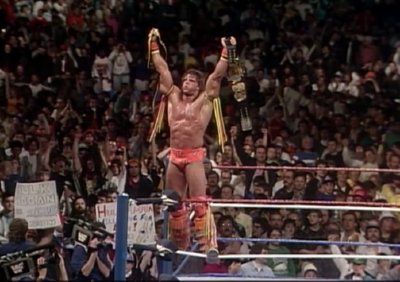
Ultimate Warrior at WrestleMania 6 in Toronto.
Professional wrestling championships have a hierarchy. They give shine to talent who occupy different spots on a card. This is one of the few things WWE did right in its early 2000s bid to rationalize its championships. The IC and US belts were (and still are) analogs. Unifying them was a lateral move that led to one workhorse mid-card title. The European Championship occupied a rung below and frequently incorporated comedy. Efforts to unify the European and Intercontinental titles either meant enhancing the European title via its association with the Intercontinental Champion — see Kurt Angle, who coined the term ‘Euro-Continental Champion’, or a step up for a victorious European champion, like D-Lo Brown, who was seen as climbing up a notch in the WWF firmament. Jeff Jarrett would beat Brown for both belts, then devalue the European title again by gifting it to Mark Henry. The last dual champion was the aforementioned Rob Van Dam, who assimilated secondary titles like a singlet-wearing, weed-smoking Borg.
I’ve written before about the challenges associated with wrestling mergers and acquisitions. One of the reasons why these transactions often fail is because they promise two sets of equally billed stars meeting in a series of dream matches. Business and politics invariably hamper those programs.
In 1987 Jim Crockett Promotions (JCP) purchased Bill Watts’ Universal Wrestling Federation (UWF), including a portion of its roster. The acquisition followed Crockett’s purchase of the NWA’s Florida and Kansas City affiliates to forestall the WWF’s national expansion. Most of these smaller promotions were simply absorbed into Crockett’s machine, but the UWF, which had built its own cachet among fans for it’s developed storylines, engaging characters and hard-hitting action, retained its identity. UWF executive Jim Ross who joined Crockett as part of the deal, lobbied hard to retain the UWF’s uniqueness. He argued that a separate UWF could alternate with Crockett’s group on TV and lead to an annual ‘Super Bowl’ of pro wrestling.
Crockett’s commitment to this idea is unclear. At first, the UWF retained its identity, roster and three championships, promising a set of title unification matches. The UWF World Heavyweight and Tag Team titles would instead simply be deactivated. Reigning champ Steve ‘Dr. Death’ Williams would find out while he was on a tour of Japan (Williams would defend the UWF title at Starrcade ’87 in an uncharacteristically botch-filled match against Barry Windham, which didn’t help matters). The only title to be unified as part of Crockett continuity would be the UWF Television championship, where popular star and future poultry enthusiast Terry Taylor would be squashed by Crockett’s TV titlist Nikita Koloff. Adding insult to injury, Koloff would appear in an interview and declare that the JCP version was the only TV title.
In 1988 Verne Gagne’s American Wrestling Association (AWA) decided to merge its world heavyweight championship with the United States Wrestling Association’s (USWA) main title to create the USWA Unified World Heavyweight Championship. The USWA itself had recently been born of a merger between the Von Erichs’ World Class Championship Wrestling (WCCW) and Jerry Jarrett’s Memphis-based Continental Wrestling Association (CWA). On paper, this seemed like a good idea — an effort to counter the WWF’s and NWA’s deep pockets by tying the three biggest independent promotions together in a bid for survival.
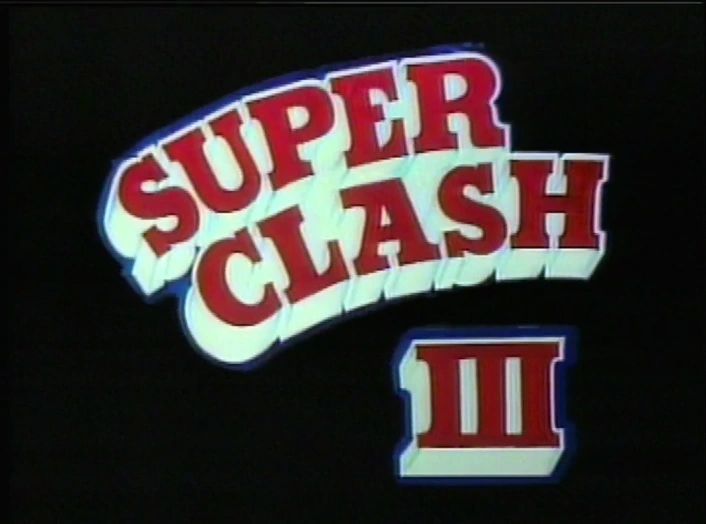
The Unified title would be a paper championship. On December 13, 1988 at the moribund SuperClash III pay per view, reigning AWA champion Jerry ‘The King’ Lawler would defeat WCCW champion Kerry Von Erich to unify the titles. The match itself was problematic for several reasons. In his autobiography Lawler remarked that Von Erich wrestled despite being in no condition to perform and had to be dragged through the match. The physical matchup between the ‘Modern-Day Warrior’, a former NWA World Champion and Lawler augured for a different result. The popular, heavily muscled Von Erich looked the part of champion alongside the WWF’s body-conscious presentation. Lawler, who worked heel and makes Eddie Kingston look formidable, did not. The match itself was severely undermined by a politics-driven finish. Lawler would win the WCCW title from Von Erich even as he was passed out from Kerry’s Iron Claw — the referee would stop the match due to Von Erich’s excessive bleeding, making Lawler ‘undisputed’ champion in the most disputable way possible.
Lawler may have won the belt but the match itself had no winners. He would later claim that due to low buyrates Gagne failed to pay him for the match. By January 1989 Lawler would be stripped of the AWA World Championship and buried by Gagne on his way out. The USWA belt would continue to be defended in Memphis, its pretense to world title status ended. By April 1989 WCCW would begin withdrawing its support for the title although the parties would go back-and-forth on its recognition. The USWA marriage would be short. WCCW would exit the USWA in late-1990 amid a flurry of lawsuits over revenue. WCCW itself would cease operations before the year was out.
AEW has flirted with the idea of its champions holding multiple titles across different companies as well. Early in AEW’s history, then-world champion Kenny Omega beat Impact World Champion Rich Swann for that promotion’s world title. At the time it felt momentous — an early opening of the Forbidden Door between promotions, which has since become one of AEW’s hallmarks and brought Don Callis into AEW full-time. At the same time, Omega also held Mexico’s AAA Mega Championship — that promotion’s version of a world heavyweight title. Between 2021 and 2022, the tag team FTR held the ROH, AAA and IWGP heavyweight tag team championships simultaneously. These reigns demanded a degree of cooperation between promotions. They added to the prestige of all the championships involved and are testament to their champions’ ability to carry off parallel title runs before audiences versed in different wrestling styles. At the same time, the stacked reigns were relatively short and Omega and FTR would wind up shedding their belts individually. Inter-promotional cooperation becomes unsustainable past a point: the tradeoff for increased visibility by having your title featured on another promotion’s show is the risk that your title (and champion) be seen as second-rate, or lent to storylines outside the home promotion’s control.
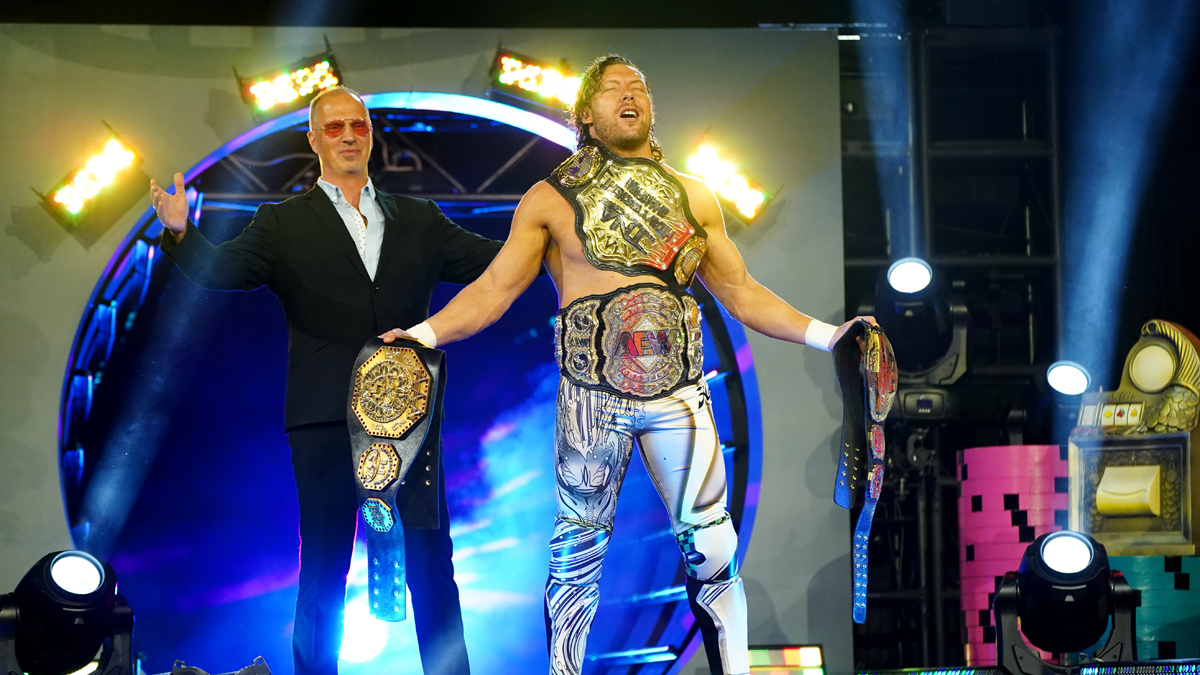
Don Callis and Kenny Omega at Double or Nothing 2021. Courtesy: AEW.
This is part of why the Impact-AEW title ballyhoo ultimately fizzled out. It also explains why purported title unification matches between larger promotions almost never reach satisfying conclusions. During the late 1970s-early 1980s wrestling fans would see a host of matches between the AWA, WWWF/WWF and NWA champions. Bob Backlund describes one such match against NWA champ Ric Flair in his autobiography. As Backlund tells it, he went into the match advised that Flair might try to legitimately steal his title or at least make him look bad to enhance the prestige of the NWA title. As it happens, Flair was more worried that Backlund (a legitimate tough guy despite his image) would hurt him for real. The two had a tense exchange backstage but both made it through their match unscathed, sending the audience home with the promise of a momentous title change unfulfilled.
And that may be the tragedy of Mr. Khan’s conversion to the AEW Continental Championship Triple Crown. By folding the ROH World Championship into a meaningless new merged title, Mr. Khan voids the ROH name altogether. For a promotion that defied the odds for so long, and introduced fans to a new and dynamic form of professional wrestling which still plays on our TV screens nightly, it’s a sad and quiet erasure of an ending.
I hope Tony Khan realized that ROH and its fans deserve better.
TOP PHOTO: Title Vs. Title Match: Claudio Castagnoli (ROH World Championship) Vs. Eddie Kingston (NJPW Strong Openweight Championship) at AEW Dynamite Grand Slam, on Wednesday, September 20, 2023, at Arthur Ashe Stadium in Queens, NY. Photo by George Tahinos, https://georgetahinos.smugmug.com
RELATED LINK
